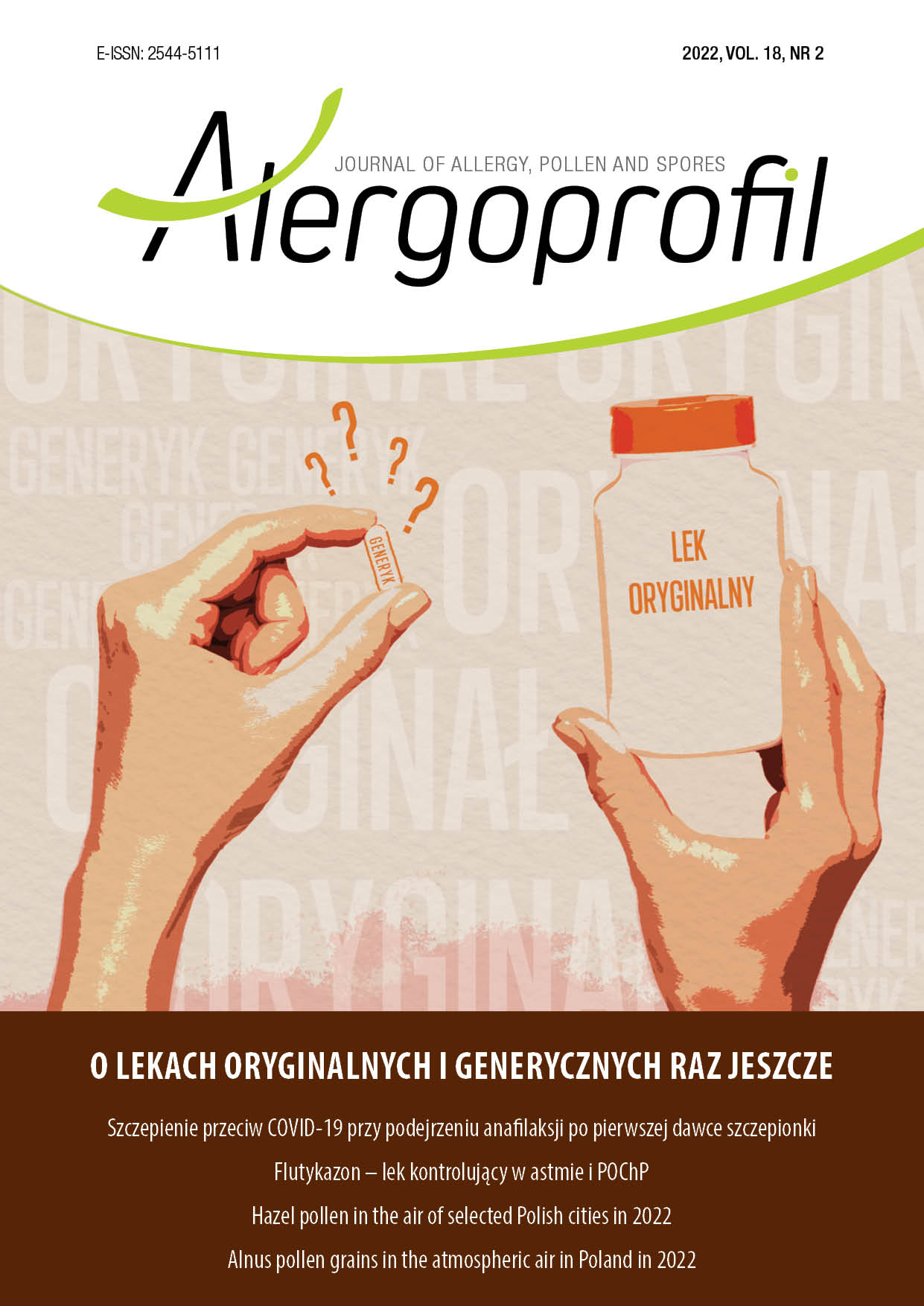Hazel pollen in the air of selected Polish cities in 2022 Original article
Main Article Content
Abstract
Hazel is an important source of tree pollen allergens, which are responsible for inhalant allergy symptoms in early spring. The aim of the study was to compare Corylus pollen season in 2022 in 12 cities located in different regions of Poland: Bialystok, Bydgoszcz, Cracow, Kielce, Lublin, Olsztyn, Piotrkow Trybunalski, Sosnowiec, Szczecin, Warsaw, Wroclaw and Zielona Gora. The measurements were conducted using a Burkard- type volumetric sampler, operating in continuous volumetric mode. The following parameters were analyzed: pollen season duration, peak value and peak date, seasonal pollen integral and number of days with concentration exceeding the threshold values triggering allergy symptoms in sensitized individuals. The hazel pollen season in 2022 began in January and the first decade of February. The earliest it began in the western regions, and the latest in eastern Poland. In most cities, maximum daily pollen concentrations were registered between February 5th and 24th. The 2022 hazel pollen season, compared to the 2021 season, was characterized by higher maximum daily pollen concentrations, higher seasonal pollen integrals (SPI) and higher number of days exceeding the threshold value for triggering allergy symptoms in most of the analyzed cities. The highest peak was recorded in Lublin (290 grains/m3) and the highest annual sum (SPI) in Cracow (2071). In 2022 the highest risk of allergy symptoms to hazel pollen allergens in sensitized individuals was found in Lublin, Cracow, Kielce and Sosnowiec.
Downloads
Article Details

This work is licensed under a Creative Commons Attribution-NonCommercial 4.0 International License.
Copyright: © Medical Education sp. z o.o. This is an Open Access article distributed under the terms of the Attribution-NonCommercial 4.0 International (CC BY-NC 4.0). License (https://creativecommons.org/licenses/by-nc/4.0/), allowing third parties to copy and redistribute the material in any medium or format and to remix, transform, and build upon the material, provided the original work is properly cited and states its license.
Address reprint requests to: Medical Education, Marcin Kuźma (marcin.kuzma@mededu.pl)
References
2. Bugała W. Drzewa i krzewy. Państwowe Wydawnictwo Rolnicze i Leśne, Warszawa 2000.
3. Wojciechowska M. Uprawa leszczyny. (access: 15.05.2022).
4. Puc M. The effect of meteorological conditions on hazel and alder pollen concentration in the air of Szczecin. Acta Agrobotanica. 2007; 60(2): 65-70.
5. Piotrowska K, Kaszewski BM. The influence of meteorological conditions on the start of the hazel (Corylus L.) pollen season in Lublin, 2001-2009. Acta Agrobotanica. 2009; 62(2): 59-66.
6. Lipiec A, Rapiejko P. Alergia czy przeziębienie – temat wciąż aktualny. Alergoprofil. 2021; 17(3): 27-33.
7. Ferreira F, Gadermaier G, Wallner M. Tree pollen allergens. Global Atlas of Allergy. 2014: 18-21.
8. Heinzerling LM, Burbach GJ, Edenharter G et al. GA2LEN skin test study I: GA²LEN harmonization of skin prick testing: novel sensitization patterns for inhalant allergens in Europe. Allergy. 2009; 64(10): 1498-506.
9. Burbach GJ, Heinzerling LM, Edenharter G et al. GA(2)LEN skin test study II: clinical relevance of inhalant allergen sensitizations in Europe. Allergy. 2009; 64: 1507‐15.
10. Hoffmann K, Hilger Ch, Santos A et al. Molecular Allergology. User’s Guide 2.0. European Academy of Allergy and Clinical Immunology 2022.
11. Werfel T, Asero R, Ballmer-Weber BK et al. Position paper of the EAACI: food allergy due to immunological cross-reactions with common inhalant allergens. Allergy. 2015; 70: 1079-90.
12. Burge HA. Monitoring for airborne allergens. Ann Allergy. 1992; 9: 9-21.
13. Mandrioli P, Comtois P, Dominguez Vilches E et al. Sampling: Principles and Techniques. In: Mandrioli P, Comtois P, Levizzani V (ed). Methods in Aerobiology. Pitagora Editrice, Bologna 1998: 47–112.
14. Emberlin J, Savage M, Jones S. Annual variations in grass pollen seasons in London 1961-1990: trends and forecast models. Clin Exp Allergy. 1993; 23(11): 911-8.
15. Galan C, Artaitti A, Bonnini M et al. Recommended terminology for aerobiological studies. Aerobiologia. 2017: 293-5.
16. Rapiejko P, Stankiewicz W, Szczygielski K et al. Threshold pollen count necessary to evoke allergic symptoms. Otolaryngol Pol. 2007; 61(4): 591-4.
17. Piotrowska-Weryszko K, Weryszko-Chmielewska E. Charakterystyka sezonów pyłkowych leszczyny i olszy w Lublinie w roku 2014. Alergoprofil. 2014; 10(2): 21-3.
18. Rapiejko P, Puc M, Malkiewicz M et al. Hazel pollen in the air of selected Polish cities. Alergoprofil. 2015; 11(3): 40-4.
19. Piotrowska-Weryszko K, Weryszko-Chmielewska E, Sulborska A et al. Corylus pollen season in southern Poland in 2016. Alergoprofil. 2016; 12(2): 87-91.
20. Malkiewicz M, Piotrowska-Weryszko K, Chłopek K et al. The analysis of hazel pollen season in southern Poland in 2017. Alergoprofil. 2017; 13(2): 72-6.
21. Puc M, Rapiejko P, Stacewicz A et al. Hazel pollen in the air of northern Poland in 2017. Alergoprofil. 2017; 13(2): 68-71.
22. Piotrowska-Weryszko K, Konarska A, Kaszewski BM et al. Analysis of Corylus pollen seasons in selected cities of Poland in 2018. Alergoprofil. 2018; 14(1): 21-6.
23. Piotrowska-Weryszko K, Konarska A, Puc M et al. Corylus pollen season in Poland in 2019. Alergoprofil. 2019; 15(1): 16-21.
24. Piotrowska-Weryszko K, Konarska A, Puc M et al. Analysis of Corylus pollen season in Poland in 2020. Alergoprofil. 2020; 16(1): 34-9.
25. Piotrowska-Weryszko K, Weryszko-Chmielewska E, Dąbrowska- Zapart K et al. Analysis of Corylus pollen season in Poland in 2021. Alergoprofil. 2021; 17(2): 54-9.

